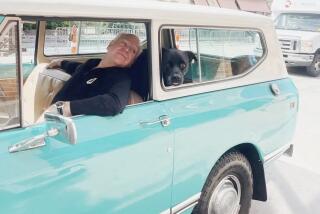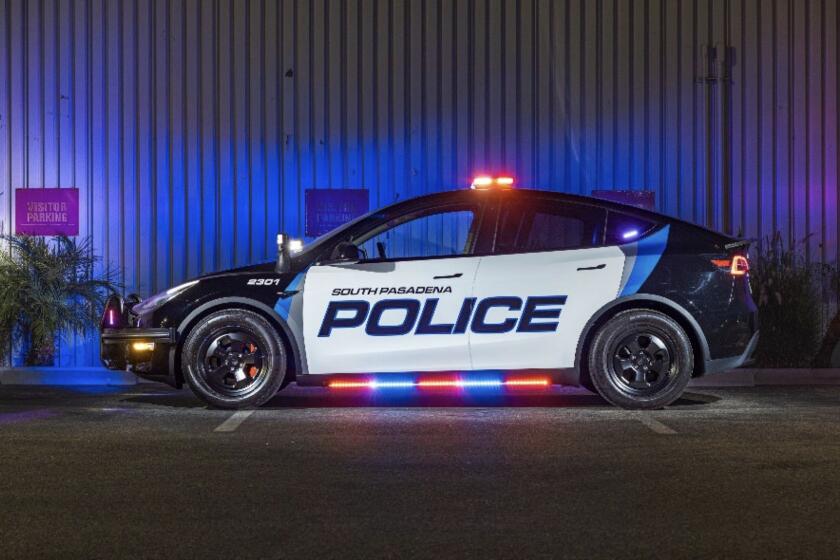2014 Corvette Stingray shifts away from tradition
The roar of eight cylinders echoes off the hillsides as the 2014 Chevrolet Corvette Stingray rushes past vineyards and sun-faded barns. The magnetic suspension grips the uneven pavement; the manual gearbox rips through seven crisp shifts as the horizon blurs.
After months of anticipation and hype, Chevrolet is finally letting the next-generation Corvette out for test drives as the automotive media descends on Monterey Car Week.
Though brief, our dalliance with a coupe version revealed that General Motors has hit the mark, balancing a towering legacy with the technological demands of a new century. A major step forward in the Corvette’s evolution, the Stingray nonetheless sticks to the 60-year-old formula — premium power and handling on a Chevrolet budget.
PHOTOS: The 2014 Corvette Stingray in detail
With 455 horsepower and a $52,000 base price, no one will argue with the performance; many will argue with the styling, which dumps the iconic round taillights and soft curves in favor of an angular profile that gives this seventh-generation ‘Vette a digital look.
PHOTOS: Seven generations of Corvettes
The new look grabs attention but lacks emotion; though meant to capture a younger audience, the changes don’t necessarily make the car more youthful. This could prove to be this generation’s only significant flaw.
Chevrolet’s need to lure younger fans can’t be overstated. From 2008 through June 2013, half of all new Corvettes were registered by individuals ages 55 and over, according to R.L. Polk & Co. Just 2.6% of buyers were ages 34 and under. This has earned the Corvette a reputation as the natural habitat for aging men seeking the trappings of youth.
“We’re trying to get away from that,” said Josh Holder, the engineering manager who oversaw the development of this Corvette. “Our customer base is going to die off.”
The marketing isn’t subtle. Two months before revealing the car at the Detroit Auto Show, Chevrolet released a digitized version of the car — wrapped in camouflage — for players of the Sony PlayStation game “Gran Turismo.” More than 500,000 people downloaded it. When the official car was released this January, an additional 1.6 million users downloaded that version.
In the physical realm, Chevrolet also deviated from the design playbook. The C7, as the Corvette cognoscente call it, is the first model without two sets of round taillights since 1961. They’re trapezoids now, with black vents on the outside of each pair resembling streaks of mascara.
The deliberate shift from tradition sets the C7 apart from earlier Corvettes on the road, said Kirk Bennion, the man in charge of the new car’s exterior design. The reception to the change has been less than positive — often, “looks like a Camaro.” But Bennion and Holder aren’t bothered.
“If we made it too easy for everyone to like, they’d be tired of it in two years,” Bennion said.
The design looks better — if no less edgy — in person. There’s a three-dimensionality to the LED taillights that photos don’t capture.
Myriad other changes are less obvious but more substantive: The hood and removable roof panel are now carbon fiber. The wheelbase is an inch longer, while the overall length grows 2.4 inches. The car is 1.3 inches wider and even rides a bit lower. An aluminum frame sheds about 100 pounds over the previous model’s steel frame, but total weight increases 100 pounds.
The exterior may be controversial, but few dispute the interior was overdue for an overhaul. The new cabin is a clear upgrade in sound isolation, quality of materials and fit and finish.
Thoughtful touches abound, like a fully customizable digital instrument panel and the small redundant climate control buttons for the passenger near their door.
Complaints here are few. Taller drivers will yearn for a bit more legroom, and a large grab handle in the middle of the console blocks the passenger’s view of most of the buttons and screen.
The model we spent the most time in sells for $71,660 and included the 3LT package. For $8,000, buyers get a suite of luxury touches including power heated and cooled Napa leather seats, a touch-screen navigation system with Chevy’s MyLink infotainment setup and a heads-up display.
Also bundled on our tester was the $2,800 Z51 performance package — a must-have, as it includes performance-oriented gear ratios, an electronically controlled limited slip differential, separate transmission cooling system, and 19-inch wheels up front and 20-inch wheels in the back.
Continuing the performance trend, the Lime Rock Metallic car we tested also included the Magnetic Ride Control suspension setup for $1,795 and the dual-mode performance exhaust for $1,195.
All 2014 Corvettes come with a 6.2-liter V-8 engine that makes 455 horsepower and 460 pound-feet of torque (the optional exhaust system adds five to each of those figures). Zero to 60 mph passes in a mere 3.8 seconds in the Z51 optioned ‘Vette. And yet the car manages 17 miles per gallon in the city and 29 mpg on the highway, thanks to direct fuel injection and a cylinder deactivation system that shuts off four of the eight cylinders during freeway cruising.
Two transmissions are available: a seven-speed manual gearbox with active rev-matching, or a six-speed automatic transmission with paddle shifters.
All these changes make for an incredibly compelling sports car. The previous Corvette required some seat time to get comfortable pushing its limits; the C7 is ready to dance right out of the box.
The engine has a throaty yet refined voice that barks out of the quad exhaust pipes. Power delivery is smooth throughout the rev range, and there’s always plenty on tap.
Although an automatic transmission could have been an afterthought on this car, it’s a solid gearbox that shifts quickly in manual or automatic mode. But get the stick shift. The clutch is easy to modulate and the shifter has a heavy feel but still finds most of its gates without trouble.
This 2014 Corvette isn’t a small car, but it never feels heavy. This helps the C7 dart through corners with precision and poise. The Corvette’s steering wheel is now smaller and Chevy says the steering is stiffer, but it transmitted a confident feel for the road.
A subtle electronic limited slip differential allows you to easily shake the rear of the car loose with predictable oversteer, if that’s your thing. Even if it’s not, the car’s power is always approachable and useful to a wide range of drivers.
The edgy styling that Chevy sees as crucial to the Corvette’s future may not be for everyone — but the rest of the car absolutely is.
david.undercoffler@latimes.com







